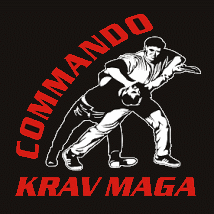Q: What is Commando Krav Maga
A: Commando Krav Maga is the Krav Maga system as devised by Moni Aizik. The System was officially born in 1973 when Aizik was asked by the Israel Defense Forces (IDF) to revamp their current Krav Maga program. Where other Krav Maga systems have focused primarily on the civilian market and made attempts to become a 'martial art' in the traditional sense; Aizik's system still keeps its footing as a military self defense system with some modifications made for civilian students.
(Source: http://en.wikipedia.org/wiki/Commando_Krav_Maga)
Q: How does Commando Krav Maga teach weapons defense?
A: One of the things that distinguishes Commando Krav Maga from other Krav Maga systems is the use of continuous surprise attacks. This is where an individual is surrounded by various students (some armed some not) who repeatedly attack with little rest in between. The individual has to react instinctively to gun threats, knife threats, punches, throws, kicks etc.
This type of training allows the student to get used to the way that a fight can flow from a gun threat, into a fist fight which may then turn into a knife fight. This recognition of the multiple dimensions that a single fight can encompass is one of Commando Krav Magas distinguishing features.
(Source: http://en.wikipedia.org/wiki/Commando_Krav_Maga)
Q: How do I start?
A: Just turn up and give a class a try with no financial obligation. There is no need for induction courses. After that, if you wish to continue you can sign up for the various Beginners Packages available throughout the season. Speak to your instructor individually about these.
Q: What do I need to wear?
A: To start with, just wear regular training gear, i.e. loose fitting top, tracksuit bottoms/kickboxing pants and trainers. We’ll talk to you at class about protective gear etc. Later into your training, we’d like you to wear a Commando Krav Maga t-shirt when training; again we’ll talk about this at class.
Q: Any age limits?
A: It’s ok to start at 15 and over though this will be a decision for the individual instructor; some 14-year olds can be suitable whereas some older teenagers may not.
There is no upper age limit though (again) suitability will be a decision for the individual instructor.
Q: Do I need to be very fit?
A: No, all levels of fitness are welcome; you don’t need to be an Olympic athlete to learn how to defend yourself. The intensity of your training will vary according to your age and fitness, but it’s an important principle for us that Commando Krav Maga is available to as many people as is practical. The training will certainly help you get fitter.
Q: Is there is a grading system?
A: Yes, however it’s there to provide a structure and progression system. We don’t use a belt system for this program.
Q: Is it suitable for women?
A: Absolutely!
Q: How does Commando Krav Maga differ from other styles of Krav Maga available?
A: Read the following posts on the Commando Krav Maga forum from two instructors who have passed the first Instructor seminar in the UK. Between them these two instructors have a wider experience than anybody in the UK of Israeli Martial arts having trained and/or been instructors with the IKMF, the IKMA (in Israel), WKMA (In America), Kapap and now, Commando Krav Maga.
1st Post
"Having just completed (and passed) the Level 1 & 2 CKM Course, I'd like to mention a few of the differences I found with CKM versus some of the other Krav Maga systems that I've done - Hopefully this will help some of the guys who have been asking questions, surrounding, 'How is Commando Krav Maga different from the other Krav Maga systems?'.
1) Use of Gross Motor Skills & Simplicity
If you look at 'what works' be it in the Octagon, in Competition or on the street, movements/techniques that utilize large, gross motor movements tend to be the successful ones i.e. the bigger the movement the easier it is to pull off (shooting to the legs is far more likely to be pulled off than an intricate step and trip technique).
The Commando Krav Maga techniques are 'big', simple composite body movements rather than lots of 'smaller' techniques that are applied in some sort of sequence...and any sequence of moves has a high chance of getting interrupted.
As Moni says, 'Simplicity is genius'.
If it's big and simple your a) more likely to remember it and b) more likely to get it to work under stress.
2) Emphasis on Balance
The first thing, the very first thing that Commando Krav Maga teaches is to regain/gain balance e.g. it's no good reaching the hands up against a choke if you're being pushed to the ground.
3) Realistic Attacks
In the streets attacks aren't static they are applied with movement. Much of the previous Krav Maga I learned had chokes and strangles from static positions, where the person just stood and choked rather than tried to pull you to to the ground, take you off your feet.
4) What If...
This is maybe one of the biggest differences with other Krav Maga systems: all techniques are viewed at from the attackers perspective e.g. If I'm threatening someone with a gun and they go to grab it what am I going to do, how am I - as the attacker - going to react?
5) Leaving The Danger Zone
Although many Krav Maga styles pay lip service to this they don't put it into practice. As soon as an attack is dealt with, your taught to control or get away, not to stay and punish the guy with punches and kick. Not disengaging could mean you end up having to deal with another more serious attack e.g. the guy pulls a knife.
I look back and consider what I was taught and Knife threats/attacks were always dealt with from the starting assumption that the fight starts with the knife being shown/used, not that it may get pulled in the middle of a fight....when you're punching and kicking the attacker.
The fact that Command Krav Maga looks at the position you are in throughout the conflict with the view that the attacker might pull a weapon at a later stage is one of CKM's major benefits.
I'm a convert to commando Krav Maga because it truly embodies what I was always told the Krav Maga I learned did - but didn't e.g. reuse of techniques, use of natural reactions etc.
I have 7 years experience in other Krav Maga systems and giving that up was hard but when you know the right way you've got to follow it and that's Commando Krav Maga for me."
_____________________________________________________________________________
2nd Post
Q: How does Commando Krav Maga differ from other styles of Krav Maga available?
"For me there are 2 key differences:
1. Balance. Crucial in any confrontation and neglected in other Krav Maga styles - indeed the latter's basic technique against a front choke actually compromises the victim's balance further than the choke itself.
2. Less reliance on punching. In other styles the differences against knives and guns rely heavily on quick counter-punching. Apart from actually increasing the danger in some cases by forcing the attacker away from you - thereby increasing the risk of a knife-slash or their retaining the gun - these techniques are little use for smaller people against larger opponents. Also, what if the attacker keeps a hand up defending a punch? These styles seem to assume that the attacker with a weapon will be sporting and allow himself to be punched and then counter-attacked continually.
I've trained with the 2 major Krav Maga organizations based in Israel and have to say that there are significant problems with their weapons defenses; these problems made me investigate Commando Krav Maga in the first place and I'm very glad that I did - and so are my students"
Some content revised from www.commandokravmaga.co.uk
| 



